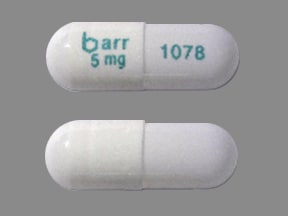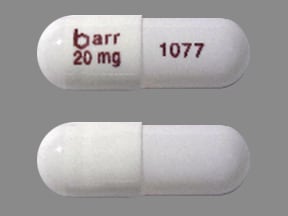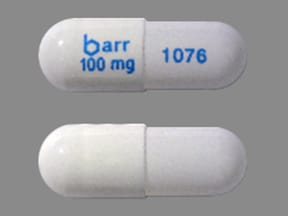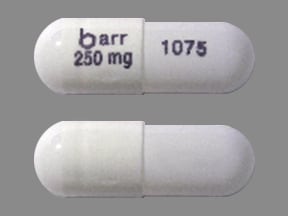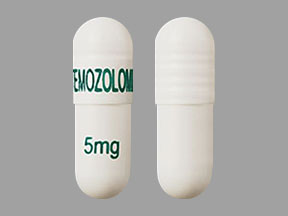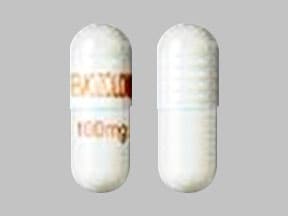Dosage Forms
Excipient information presented when available (limited, particularly for generics); consult specific product labeling.
Capsule, Oral:
Temodar: 5 mg [contains fd&c blue #2 (indigotine)]
Temodar: 20 mg, 100 mg
Temodar: 140 mg [contains fd&c blue #2 (indigotine)]
Temodar: 180 mg, 250 mg
Generic: 5 mg, 20 mg, 100 mg, 140 mg, 180 mg, 250 mg
Solution Reconstituted, Intravenous [preservative free]:
Temodar: 100 mg (1 ea) [pyrogen free; contains polysorbate 80]
Pharmacology
Mechanism of Action
Temozolomide is a prodrug which is rapidly and nonenzymatically converted to the active alkylating metabolite MTIC [(methyl-triazene-1-yl)-imidazole-4-carboxamide]; this conversion is spontaneous, nonenzymatic, and occurs under physiologic conditions in all tissues to which it distributes (Marchesi 2007; Villano 2009). The cytotoxic effects of MTIC are manifested through alkylation (methylation) of DNA at the O6, N7 guanine positions which lead to DNA double strand breaks and apoptosis (Villano 2009). Temozolomide is noncell cycle specific (Marchesi 2007).
Pharmacokinetics/Pharmacodynamics
Absorption
Oral: Rapid and complete
Distribution
Vd: Parent drug: 0.4 L/kg. Temozolomide penetrates blood-brain barrier; cerebrospinal fluid levels are ~35% to 39% of plasma levels (Yung 1999).
Metabolism
Prodrug, hydrolyzed to the active form, MTIC; MTIC is eventually eliminated as CO2 and 5-aminoimidazole-4-carboxamide (AIC), a natural constituent in urine; CYP isoenzymes play only a minor role in metabolism (of temozolomide and MTIC)
Excretion
Urine (~38%; parent drug 6%; AIC 12%); feces <1%.
Clearance: 5.5 L/hour/m2; pediatric subjects 3 to 17 years have similar temozolomide clearance as adults.
Time to Peak
Oral: Median: 1 hour; with food (high-fat meal): 2.25 hours.
Half-Life Elimination
Mean: Parent drug: Children: 1.7 hours; Adults: 1.8 hours
Protein Binding
15%
Use in Specific Populations
Special Populations: Gender
Females may have an ~5% lower temozolomide clearance (adjusted for body surface area) than males.
Use: Labeled Indications
Anaplastic astrocytoma (refractory): Treatment of refractory anaplastic astrocytoma in adults who have experienced disease progression on a regimen containing a nitrosourea and procarbazine.
Glioblastoma (newly diagnosed): Treatment of newly diagnosed glioblastoma in adults (initially in combination with radiotherapy, then as maintenance treatment).
Use: Off Label
Anaplastic gliomasb
Data from a randomized phase 3 study support the use of temozolomide in the management of newly diagnosed anaplastic gliomas Wick 2009. Interim data from a randomized phase 3 study support the use of temozolomide (in combination with radiation therapy, followed by temozolomide adjuvant therapy) for the treatment of anaplastic glioma with oligodendroglial features and 1p/19q non-co-deletion van den Bent 2017. Data from a phase 2 study also support the use of temozolomide in the treatment of newly diagnosed anaplastic oligodendroglioma, as initial therapy in patients with chromosome 1p/19q loss, and in combination with radiation therapy in patients without chromosome 1p/19q loss Mikkelsen 2009. Data from a small phase 2 study support the use of temozolomide in the treatment of newly diagnosed anaplastic oligodendroglioma Gan 2010. Data from another phase 2 study support the use of temozolomide in the treatment of anaplastic oligodendroglioma that has progressed following surgery and radiation therapy Brandes 2006.
Astrocytoma (low-grade)/oligodendroglioma (low grade)b
Preliminary data from a phase 2 study support the use of temozolomide (in combination with radiation therapy, followed by temozolomide adjuvant therapy) for the treatment of low-grade gliomas Fisher 2015. Data from a small retrospective study also suggest that temozolomide may be beneficial in the treatment of low-grade gliomas, including low-grade astrocytoma and low-grade oligodendroglioma Pouratian 2007.
CNS metastases (from solid tumors)b
Data from phase 2 studies support the use of temozolomide in the management of brain metastases due to solid tumors, including metastases from breast cancer, melanoma, and non-small cell lung cancer Abrey 2001, Agarwala 2004, Christodoulou 2001, Siena 2010, Trudeau 2006.
Cutaneous T-cell lymphomas (mycosis fungoides and Sézary syndrome), advancedb
Data from a small open-label, multicenter, phase 2 trial support the use of temozolomide in the treatment of advanced cutaneous T-cell lymphomas (mycosis fungoides and Sézary syndrome) in patients who had failed at least one prior systemic therapy Querfeld 2011.
Ewing sarcoma (recurrent or progressive)c
Data from a small retrospective study suggest that temozolomide (in combination with irinotecan) may be of benefit in the treatment of recurrent or progressive Ewing sarcoma Casey 2009. Data from another smaller retrospective review also support the use of temozolomide (in combination with irinotecan) in the management of advanced Ewing sarcoma Wagner 2007.
Glioblastoma (recurrent, relapsed, or progressive)a
Data from a large randomized, phase 3 study support the use of temozolomide in the management of chemotherapy-naive recurrent glioblastoma Brada 2010. Data from 3 large open-label, multicenter, phase 2 trials support the use of temozolomide in the treatment of recurrent, relapsed, or progressive glioblastoma in patients who were previously treated with chemotherapy or radiation therapy Brada 2001, Wick 2007, Yung 2000. Data from a multicenter, phase 2 study support rechallenging with temozolomide in patients with malignant glioma following disease progression on standard temozolomide doses Perry 2010. Data from a small phase 2 trial support the use of temozolomide in the treatment of recurrent glioblastoma in patients who were previously treated with temozolomide and radiation therapy Omuro 2013.
Melanoma, metastatic malignanta
Data from a large randomized, phase 3 trial support the use of temozolomide in the management of incurable or unresectable advanced metastatic malignant melanoma Middleton 2000.
Pancreatic neuroendocrine tumors (advanced)b
Data from multiple small phase 2 studies support the use of temozolomide (in combination with either bevacizumab, capecitabine, everolimus, or thalidomide) in the treatment of advanced or metastatic pancreatic neuroendocrine tumors Chan 2012, Chan 2013, Kulke 2006, Kunz 2018. Data from 2 small retrospective studies also suggest that temozolomide (either as a single agent or in combination with capecitabine) may be beneficial in the treatment of advanced or metastatic pancreatic endocrine carcinomas Ekeblad 2007, Strosberg 2011.
Primary CNS lymphomab
Data from a small phase 2 study support the use of temozolomide (in combination with methotrexate, leucovorin, and rituximab) for the treatment of newly diagnosed primary CNS lymphoma Rubenstein 2013. Data from a limited number of patients in two small studies suggest that temozolomide (in combination with rituximab) may be beneficial as salvage treatment of relapsed or refractory primary CNS lymphoma Enting 2004, Wong 2004.
Soft tissue sarcomas, advancedb
Data from a phase 2 study support the use of temozolomide in the treatment of metastatic or unresectable locally advanced soft tissue sarcoma Garcia del Muro 2005.
Soft tissue sarcoma, hemangiopericytoma/solitary fibrous tumorc
Data from a limited number of patients in small retrospective study clinical trials suggest that temozolomide may be beneficial for the treatment of advanced, recurrent, or metastatic hemangiopericytoma/solitary fibrous tumor Park 2011.
Contraindications
Hypersensitivity to temozolomide or any component of the formulation; hypersensitivity to dacarbazine (both drugs are metabolized to [methyl-triazene-1-yl]-imidazole-4-carboxamide).
Canadian labeling: Additional contraindications (not in the US labeling): Not recommended in patients with severe myelosuppression.
Dosage and Administration
Dosing: Adult
Note: Temozolomide is associated with a moderate emetic potential (Hesketh 2017; Roila 2016); antiemetics are recommended to prevent nausea and vomiting. Pneumocystis jirovecii pneumonia prophylaxis is required during concomitant phase (with radiation therapy) and should continue in patients who develop lymphocytopenia until lymphocyte recovery to ≤ grade 1. ANC should be ≥1,500/mm3 and platelets ≥100,000/mm3 prior to administration.
Anaplastic astrocytoma (refractory): Oral, IV: Initial dose: 150 mg/m2 once daily on days 1 to 5 every 28 days. If ANC ≥1,500/mm3 and platelets ≥100,000/mm3 at the nadir and on day 1 of the next cycle, increase dose to 200 mg/m2 on days 1 to 5 every 28 days and continue until disease progression or unacceptable toxicity (in the clinical trial, temozolomide could be continued for up to a maximum of 2 years, although the optimal treatment duration is unknown).
Dosage modification for toxicity:
Monitor CBC on day 22 and then weekly until ANC >1,500/mm3 and platelet count >100,000/mm3; do not initiate the next cycle until ANC >1,500/mm3 and platelets >100,000/mm3.
ANC <1,000/mm3 or platelets <50,000/mm3 during any cycle: Reduce temozolomide dose for the next cycle by 50 mg/m2/day. Permanently discontinue if unable to tolerate a dose of 100 mg/m2/day.
Anaplastic gliomas (off-label use): Oral: 200 mg/m2 once daily on days 1 to 5 of a 28-day treatment cycle for 8 cycles (Wick 2009) or 200 mg/m2 once daily on days 1 to 5 of a 28-day treatment cycle for 6 cycles (Gan 2010) or (in patients with chromosome 1p/19q loss) 150 mg/m2 once daily for 5 days of a 28-day treatment cycle in cycles 1 and 2, followed by 200 mg/m2 once daily for 5 days of subsequent 28-day treatment cycles (Mikkelsen 2009) or (in patients without chromosome 1p/19q loss) 150 mg/m2 once daily for 5 days of a 28-day treatment cycle in cycles 1 and 2, followed by 200 mg/m2 once daily for 5 days for up to two 28-day cycles, followed by 75 mg/m2 once daily during radiation therapy, and then followed by post-radiation temozolomide treatment (Mikkelsen 2009) or 75 mg/m2 once daily for a maximum of 7 weeks during radiation therapy and then (adjuvant therapy) 150 mg/m2 once daily for 5 days of a 28-day treatment cycle in cycle 1, followed by 200 mg/m2 once daily for 5 days of subsequent 28-day treatment cycles for up to a total of 12 adjuvant cycles (van den Bent 2017) or 150 to 200 mg/m2 once daily for 5 days of a 28-day treatment cycle for a maximum of 12 cycles in patients with a complete response or until disease progression in patients with partial response or stable disease (Brandes 2006).
Astrocytoma (low-grade)/oligodendroglioma (low grade) (off-label use): Oral: 75 mg/m2 once daily during radiation therapy and then (adjuvant therapy) 150 to 200 mg/m2 once daily for 5 days of a 28-day treatment cycle for up to 12 cycles (Fisher 2015) or (protracted single-agent therapy) 75 mg/m2 once daily for 21 days of a 28-day treatment cycle for 12 to 15 cycles (Pouratian 2007).
CNS metastases from solid tumors (off-label use): Oral: 150 mg/m2 (200 mg/m2 in chemotherapy-naïve patients) once daily for 5 days of a 28-day treatment cycle until disease progression or unacceptable toxicity up to a maximum of 1 year (Agarwala 2004) or 150 mg/m2 (200 mg/m2 in chemotherapy-naïve patients) once daily for 5 days of a 28-day treatment cycle until disease progression or unacceptable toxicity (Abrey 2001) or 150 mg/m2 once daily for 5 days of a 28-day treatment cycle until disease progression or unacceptable toxicity (Christodoulou 2001) or 150 mg/m2 once daily on days 1 to 7 and days 15 to 21 of a 28-day or 35-day treatment cycle until disease progression or unacceptable toxicity (Siena 2010) or 150 mg/m2 once daily on days 1 to 7 and days 15 to 21 of a 28-day treatment cycle for a maximum of 2 cycles after complete response, until disease progression or for 4 cycles after stable partial response, 6 cycles after stable disease, or until unacceptable toxicity (Trudeau 2006).
Cutaneous T-cell lymphoma (mycosis fungoides and Sézary syndrome), advanced (off-label use; based on limited data): Oral: 200 mg/m2 once daily for 5 days every 28 days for up to 1 year (Querfeld 2011).
Ewing sarcoma, recurrent or progressive (off-label use; based on limited data): Oral: 100 mg/m2/dose on days 1 to 5 every 21 days (in combination with irinotecan) (Casey 2009).
Glioblastoma (newly diagnosed, high-grade glioma): Oral, IV:
Concomitant phase: 75 mg/m2 once daily for 42 days (in combination with focal radiotherapy of 60 Gy administered in 30 fractions).
Continue at 75 mg/m2 once daily throughout the 42-day concomitant phase (up to 49 days) as long as ANC ≥1,500/mm3, platelet count ≥100,000/mm3, and nonhematologic toxicity ≤ grade 1 (excludes alopecia, nausea/vomiting)
Dosage modification for toxicity:
ANC ≥500/mm3 but <1,500/mm3or platelet count ≥10,000/mm3 but <100,000/mm3or grade 2 nonhematologic toxicity (excludes alopecia, nausea/vomiting): Interrupt temozolomide therapy; resume temozolomide when ANC ≥1,500/mm3, platelet count ≥100,000/mm3, and nonhematologic toxicity is resolved to ≤ grade 1.
ANC <500/mm3or platelet count <10,000/mm3or grade 3 or 4 nonhematologic toxicity (excludes alopecia, nausea/vomiting): Discontinue therapy.
Maintenance phase (consists of 6 treatment cycles): Begin 4 weeks after concomitant phase completion. A retrospective analysis of 4 randomized studies in patients with newly diagnosed glioblastoma who were progression-free following 6 cycles of adjuvant temozolomide therapy determined that continued administration beyond 6 cycles did not demonstrate improvement in overall survival (Blumenthal 2017).
Cycle 1: 150 mg/m2 once daily on days 1 to 5 of a 28-day treatment cycle.
Cycles 2 to 6: May increase to 200 mg/m2 once daily on days 1 to 5; repeat every 28 days (if ANC ≥1,500/mm3, platelets ≥100,000/mm3, and nonhematologic toxicities for cycle 1 are ≤ grade 2 [excludes alopecia, nausea/vomiting]). If dose was not escalated at the onset of cycle 2, do not increase for cycles 3 to 6.
Maintenance phase dosage modification for toxicity:
Monitor CBC on day 22 and then weekly until ANC >1,500/mm3 and platelet count >100,000/mm3.
ANC <1,000/mm3, platelet count <50,000/mm3, or grade 3 nonhematologic toxicity (excludes alopecia, nausea/vomiting) during previous cycle: Interrupt temozolomide therapy; when ANC >1,500/mm3, platelet count >100,000/mm3, and nonhematologic toxicity is resolved to ≤ grade 1, resume temozolomide at a reduced dose for the next cycle. If temozolomide is withheld, decrease dose by 50 mg/m2/day. Permanently discontinue if unable to tolerate a dose of 100 mg/m2/day.
Glioblastoma, recurrent, relapsed, or progressive (off-label use): Oral: 200 mg/m2 once daily for 5 days every 28 days; if previously treated with chemotherapy, initiate at 150 mg/m2 once daily for 5 days every 28 days and increase to 200 mg/m2 once daily for 5 days every 28 days with cycle 2 if no hematologic toxicity (Brada 2001; Yung 2000) or 200 mg/m2 once daily for 5 days every 28 days for up to 9 cycles or until disease progression (Brada 2010) or 150 mg/m2 once daily on days 1 to 7 and days 15 to 21 of a 28-day treatment cycle for a maximum of 12 cycles (Wick 2007) or 50 mg/m2 once daily for a maximum of 12 months or until disease progression (Perry 2010) or 50 mg/m2 once daily until disease progression (Omuro 2013).
Melanoma, metastatic malignant (off-label use): Oral: 200 mg/m2 once daily for 5 days every 28 days (for up to 12 cycles in the absence of disease progression or unacceptable toxicity). Reduce the dose by 25% in subsequent cycles for grade 3/4 hematologic toxicity and reduce the dose by 50% for grade 3/4 nonhematologic toxicity (Middleton 2000).
Pancreatic neuroendocrine tumors, advanced (off-label use): Oral: 150 mg/m2 once daily for 7 days every 14 days (in combination with bevacizumab) until disease progression or unacceptable toxicity (Chan 2012) or 150 mg/m2 once daily for 7 days every 14 days (in combination with everolimus) for 6 months (Chan 2013) or 150 mg/m2 once daily for 7 days every 14 days (in combination with thalidomide) until disease progression or unacceptable toxicity (Kulke 2006) or 200 mg/m2 once daily (at bedtime) on days 10 to 14 (5 days) of a 28-day treatment cycle (in combination with capecitabine) (Kunz 2018; Strosberg 2011) or (single-agent therapy) 100 to 150 mg/m2 once daily for 5 days of a 28-day treatment cycle in cycle 1, followed by 100 to 200 mg/m2 once daily for 5 days of subsequent 28-day treatment cycles (Ekeblad 2007).
Primary CNS lymphoma, newly diagnosed (off-label use; based on limited data): Oral: Induction: 150 mg/m2 once daily on days 7 to 11 each month for 5 months (in combination with 14-day cycles of high-dose methotrexate, leucovorin, and rituximab; temozolomide is administered during odd cycles), followed by consolidation therapy with etoposide and cytarabine; refer to protocol for details (Rubenstein 2013).
Primary CNS lymphoma, relapsed or refractory (off-label use; based on limited data): Oral: 150 mg/m2 once daily for 5 days every 28 days, initially in combination with rituximab (for 4 cycles), followed by temozolomide monotherapy: 150 mg/m2 once daily for 5 days every 28 days for 8 cycles (Wong 2004) or 150 mg/m2 once daily on days 1 to 7 and 15 to 21 every 28 days (initially in combination with rituximab for 1 or 2 cycles), followed by temozolomide maintenance monotherapy: 150 mg/m2 once daily for 5 days every 28 days (Enting 2004).
Soft tissue sarcomas, advanced (off-label use): Oral: 75 mg/m2 once daily for 6 weeks (Garcia del Muro 2005)
Soft tissue sarcoma, hemangiopericytoma/solitary fibrous tumor (off-label use; based on limited data): Oral: 150 mg/m2 once daily on days 1 to 7 and days 15 to 21 of a 28-day treatment cycle (in combination with bevacizumab) (Park 2011).
Dosing: Geriatric
Glioblastoma, newly diagnosed (off-label dosing): ≥65 years of age: Oral:
Concomitant phase: 75 mg/m2 once daily for 21 consecutive days during radiation therapy (in combination with a reduced radiotherapy total dose of 40.05 Gy administered in 15 daily fractions over 3 weeks) (Perry 2017).
Adjuvant/maintenance therapy: 150 to 200 mg/m2 once daily for 5 days of each 28-day treatment cycle until disease progression for up to a maximum of 12 cycles (Perry 2017).
Also refer to adult dosing.
Dosing: Pediatric
Note: Temozolomide is associated with a moderate emetic potential (Roila 2010); antiemetics are recommended to prevent nausea and vomiting. Prior to dosing, ANC should be ≥1,500/mm3 and platelets ≥100,000/mm3. Dose, frequency, number of doses, and start date may vary by protocol and treatment phase. Refer to individual protocols.
Ewing sarcoma, recurrent or progressive: Limited data available: Children ≥2 years and Adolescents: Oral: 100 mg/m2/dose once daily for 5 days, repeat cycle every 21 days (in combination with irinotecan; administer 1 hour prior to irinotecan) (Casey 2009); dosing based on a retrospective review
Neuroblastoma, relapsed or refractory: Limited data available:
Irinotecan regimen: Infants, Children, and Adolescents: Oral: 100 mg/m2/dose once daily for 5 days, repeat cycle every 21 days for up to 6 cycles; in combination with irinotecan; administer 1 hour prior to irinotecan (Bagatell 2011). Note: Temozolomide doses were rounded to the nearest capsule size.
Topotecan regimen (TOTEM): Infants ≥6 months, Children, and Adolescents: Oral: 150 mg/m2/dose on days 1 to 5 every 28 days; in combination with topotecan; administer prior to the topotecan; continue until disease progression or unacceptable toxicity up to a maximum of 12 months; doses were reduced for hematologic toxicity (Di Giannatale 2014)
Single agent: Children ≥3 years and Adolescents: Oral: Administer doses on days 1 to 5 every 21 to 28 days; continue until disease progression or unacceptable toxicity up to a maximum of 24 cycles; doses were reduced by 25% for grade 4 thrombocytopenia or neutropenia, and grade 3 or 4 mucositis, documented sepsis, pulmonary distress/infiltrate, or seizures requiring prophylaxis (De Sio 2006)
No prior craniospinal irradiation: 215 mg/m2/day
Previous craniospinal irradiation or relapse after bone-marrow transplant: 180 mg/m2/day
Solid tumors, relapsed or refractory (including but not limited to brain tumor [astrocytomas, gliomas, medulloblastoma], neuroblastoma, and sarcomas): Limited data available; efficacy results variable: Infants, Children, and Adolescents: Oral: 200 to 215 mg/m2/dose days 1 to 5 every 21 to 28 days; dose was decreased to 180 mg/m2/dose for patients who received prior craniospinal irradiation or relapsed after bone marrow transplant (De Sio 2006; Nicholson 2007); in other trials, lower doses of 160 to 200 mg/m2/dose once daily for 5 days every 28 days were used in patients 3 to 18 years of age (manufacturer labeling)
Dosing: Obesity
ASCO Guidelines for appropriate chemotherapy dosing in obese adults with cancer: Utilize patient’s actual body weight (full weight) for calculation of body surface area- or weight-based dosing, particularly when the intent of therapy is curative; manage regimen-related toxicities in the same manner as for nonobese patients; if a dose reduction is utilized due to toxicity, consider resumption of full weight-based dosing with subsequent cycles, especially if cause of toxicity (eg, hepatic or renal impairment) is resolved (Griggs 2012).
Reconstitution
IV: Bring vial(s) to room temperature prior to reconstitution. Reconstitute each 100 mg vial with 41 mL sterile water for injection to a final concentration of 2.5 mg/mL. Swirl gently; do not shake. Place dose without further dilution into a 250 mL empty sterile infusion bag. Infusion must be completed within 14 hours of reconstitution.
Extemporaneously Prepared
A 10 mg/mL temozolomide oral suspension may be compounded in a vertical flow hood. Mix the contents of ten 100 mg capsules and 500 mg of povidone K-30 powder in a glass mortar; add 25 mg anhydrous citric acid dissolved in 1.5 mL purified water and mix to a uniform paste; mix while adding 50 mL Ora-Plus in incremental proportions. Transfer to an amber plastic bottle, rinse mortar 4 times with small portions of either Ora-Sweet or Ora-Sweet SF, and add quantity of Ora-Sweet or Ora-Sweet SF sufficient to make 100 mL. Store in plastic amber prescription bottles; label "shake well" and "refrigerate"; include the beyond-use date. Stable for 7 days at room temperature or 60 days refrigerated (preferred).
Trissel LA, Yanping Z, and Koontz SE, "Temozolomide Stability in Extemporaneously Compounded Oral Suspension," Int J Pharm Compound, 2006, 10(5):396-9.
Administration
Temozolomide is associated with a moderate emetic potential (Hesketh 2017; Roila 2016); antiemetics are recommended to prevent nausea and vomiting.
Oral: Swallow capsules whole with a full glass of water; do not open or chew. Administer consistently with respect to food (either consistently fasting or nonfasting). Administer on an empty stomach and/or at bedtime to reduce nausea and vomiting. Do not repeat dose if vomiting occurs after dose is administered; wait until the next scheduled dose. If capsules are accidently opened or damaged, avoid inhalation or contact with skin or mucous membranes.
IV: Infuse over 90 minutes (shorter or longer infusion times may result in suboptimal dosing). Flush line before and after administration. May be administered through the same IV line as sodium chloride 0.9%; do not administer other solutions or medications through the same IV line.
Storage
Capsule: Store at 25°C (77°F); excursions permitted to 15°C to 30°C (59°F to 86°F).
Injection: Store intact vials at 2°C to 8°C (36°F to 46°F). Reconstituted vials may be stored for up to 14 hours at room temperature of 25°C (77°F); infusion must be completed within 14 hours of reconstitution.
Temozolomide Images
Drug Interactions
Baricitinib: Immunosuppressants may enhance the immunosuppressive effect of Baricitinib. Management: Use of baricitinib in combination with potent immunosuppressants such as azathioprine or cyclosporine is not recommended. Concurrent use with antirheumatic doses of methotrexate or nonbiologic disease modifying antirheumatic drugs (DMARDs) is permitted. Consider therapy modification
BCG (Intravesical): Immunosuppressants may diminish the therapeutic effect of BCG (Intravesical). Avoid combination
BCG (Intravesical): Myelosuppressive Agents may diminish the therapeutic effect of BCG (Intravesical). Avoid combination
Chloramphenicol (Ophthalmic): May enhance the adverse/toxic effect of Myelosuppressive Agents. Monitor therapy
Cladribine: May enhance the immunosuppressive effect of Immunosuppressants. Avoid combination
Cladribine: May enhance the myelosuppressive effect of Myelosuppressive Agents. Avoid combination
CloZAPine: Myelosuppressive Agents may enhance the adverse/toxic effect of CloZAPine. Specifically, the risk for neutropenia may be increased. Monitor therapy
Coccidioides immitis Skin Test: Immunosuppressants may diminish the diagnostic effect of Coccidioides immitis Skin Test. Monitor therapy
Deferiprone: Myelosuppressive Agents may enhance the neutropenic effect of Deferiprone. Management: Avoid the concomitant use of deferiprone and myelosuppressive agents whenever possible. If this combination cannot be avoided, monitor the absolute neutrophil count more closely. Consider therapy modification
Denosumab: May enhance the adverse/toxic effect of Immunosuppressants. Specifically, the risk for serious infections may be increased. Monitor therapy
Dipyrone: May enhance the adverse/toxic effect of Myelosuppressive Agents. Specifically, the risk for agranulocytosis and pancytopenia may be increased Avoid combination
Echinacea: May diminish the therapeutic effect of Immunosuppressants. Consider therapy modification
Fingolimod: Immunosuppressants may enhance the immunosuppressive effect of Fingolimod. Management: Avoid the concomitant use of fingolimod and other immunosuppressants when possible. If combined, monitor patients closely for additive immunosuppressant effects (eg, infections). Consider therapy modification
Leflunomide: Immunosuppressants may enhance the adverse/toxic effect of Leflunomide. Specifically, the risk for hematologic toxicity such as pancytopenia, agranulocytosis, and/or thrombocytopenia may be increased. Management: Consider not using a leflunomide loading dose in patients receiving other immunosuppressants. Patients receiving both leflunomide and another immunosuppressant should be monitored for bone marrow suppression at least monthly. Consider therapy modification
Lenograstim: Antineoplastic Agents may diminish the therapeutic effect of Lenograstim. Management: Avoid the use of lenograstim 24 hours before until 24 hours after the completion of myelosuppressive cytotoxic chemotherapy. Consider therapy modification
Lipegfilgrastim: Antineoplastic Agents may diminish the therapeutic effect of Lipegfilgrastim. Management: Avoid concomitant use of lipegfilgrastim and myelosuppressive cytotoxic chemotherapy. Lipegfilgrastim should be administered at least 24 hours after the completion of myelosuppressive cytotoxic chemotherapy. Consider therapy modification
Mesalamine: May enhance the myelosuppressive effect of Myelosuppressive Agents. Monitor therapy
Natalizumab: Immunosuppressants may enhance the adverse/toxic effect of Natalizumab. Specifically, the risk of concurrent infection may be increased. Avoid combination
Nivolumab: Immunosuppressants may diminish the therapeutic effect of Nivolumab. Consider therapy modification
Ocrelizumab: May enhance the immunosuppressive effect of Immunosuppressants. Monitor therapy
Palifermin: May enhance the adverse/toxic effect of Antineoplastic Agents. Specifically, the duration and severity of oral mucositis may be increased. Management: Do not administer palifermin within 24 hours before, during infusion of, or within 24 hours after administration of myelotoxic chemotherapy. Consider therapy modification
Pidotimod: Immunosuppressants may diminish the therapeutic effect of Pidotimod. Monitor therapy
Pimecrolimus: May enhance the adverse/toxic effect of Immunosuppressants. Avoid combination
Promazine: May enhance the myelosuppressive effect of Myelosuppressive Agents. Monitor therapy
Roflumilast: May enhance the immunosuppressive effect of Immunosuppressants. Consider therapy modification
Siponimod: Immunosuppressants may enhance the immunosuppressive effect of Siponimod. Monitor therapy
Sipuleucel-T: Immunosuppressants may diminish the therapeutic effect of Sipuleucel-T. Management: Evaluate patients to see if it is medically appropriate to reduce or discontinue therapy with immunosuppressants prior to initiating sipuleucel-T therapy. Consider therapy modification
Smallpox and Monkeypox Vaccine (Live): Immunosuppressants may diminish the therapeutic effect of Smallpox and Monkeypox Vaccine (Live). Monitor therapy
Tacrolimus (Topical): May enhance the adverse/toxic effect of Immunosuppressants. Avoid combination
Tofacitinib: Immunosuppressants may enhance the immunosuppressive effect of Tofacitinib. Management: Concurrent use with antirheumatic doses of methotrexate or nonbiologic disease modifying antirheumatic drugs (DMARDs) is permitted, and this warning seems particularly focused on more potent immunosuppressants. Consider therapy modification
Trastuzumab: May enhance the neutropenic effect of Immunosuppressants. Monitor therapy
Upadacitinib: Immunosuppressants may enhance the immunosuppressive effect of Upadacitinib. Avoid combination
Vaccines (Inactivated): Immunosuppressants may diminish the therapeutic effect of Vaccines (Inactivated). Management: Vaccine efficacy may be reduced. Complete all age-appropriate vaccinations at least 2 weeks prior to starting an immunosuppressant. If vaccinated during immunosuppressant therapy, revaccinate at least 3 months after immunosuppressant discontinuation. Consider therapy modification
Vaccines (Live): Immunosuppressants may enhance the adverse/toxic effect of Vaccines (Live). Immunosuppressants may diminish the therapeutic effect of Vaccines (Live). Management: Avoid use of live organism vaccines with immunosuppressants; live-attenuated vaccines should not be given for at least 3 months after immunosuppressants. Exceptions: Smallpox and Monkeypox Vaccine (Live). Avoid combination
Valproate Products: May enhance the adverse/toxic effect of Temozolomide. Valproate Products may increase the serum concentration of Temozolomide. Monitor therapy
Adverse Reactions
With CNS malignancies, it may be difficult to distinguish between CNS adverse events caused by temozolomide versus the effects of progressive disease.
>10%:
Cardiovascular: Peripheral edema (11%)
Central nervous system: Fatigue (34% to 61%), headache (23% to 41%), seizure (6% to 23%), hemiparesis (18%), dizziness (5% to 12%), ataxia (8% to 11%)
Dermatologic: Alopecia (55%), skin rash (8% to 13%)
Gastrointestinal: Nausea (49% to 53%), vomiting (29% to 42%), constipation (22% to 33%), anorexia (9% to 27%), diarrhea (10% to 16%)
Hematologic & oncologic: Lymphocytopenia (grades 3/4: 55%), thrombocytopenia (grades 3/4: adults: 4% to 19%; children: 25%), neutropenia (grades 3/4: adults: 8% to 14%; children: 20%), leukopenia (grades 3/4: 11%)
Infection: Viral infection (11%)
Neuromuscular & skeletal: Weakness (7% to 13%)
Miscellaneous: Fever (13%)
1% to 10%:
Central nervous system: Amnesia (10%), insomnia (4% to 10%), drowsiness (9%), paresthesia (9%), paresis (8%), anxiety (7%), memory impairment (7%), abnormal gait (6%), depression (6%), confusion (5%)
Dermatologic: Pruritus (5% to 8%), xeroderma (5%), erythema (1%)
Endocrine & metabolic: Hypercorticoidism (8%), weight gain (5%)
Gastrointestinal: Stomatitis (9%), abdominal pain (5% to 9%), dysphagia (7%), dysgeusia (5%)
Genitourinary: Urinary incontinence (8%), urinary tract infection (8%), mastalgia (females 6%), urinary frequency (6%)
Hematologic & oncologic: Anemia (grades 3/4: 4%)
Hypersensitivity: Hypersensitivity reaction (≤3%)
Neuromuscular & skeletal: Back pain (8%), arthralgia (6%), myalgia (5%)
Ophthalmic: Blurred vision (5% to 8%), diplopia (5%), visual disturbance (visual deficit/vision changes 5%)
Respiratory: Pharyngitis (8%), upper respiratory tract infection (8%), cough (5% to 8%), sinusitis (6%), dyspnea (5%)
Miscellaneous: Radiation injury (2% maintenance phase after radiotherapy)
<1%, postmarketing, and/or case reports: Agitation, anaphylaxis, apathy, aplastic anemia, bacterial infection, cholestasis, cytomegalovirus disease (primary and reactivation), diabetes insipidus, emotional lability, erythema multiforme, febrile neutropenia, flu-like symptoms, fungal infection, hallucination, hematoma, hemorrhage, hepatitis, hepatitis B (reactivation), hepatotoxicity, herpes simplex infection, herpes zoster, hyperbilirubinemia, hyperglycemia, hypersensitivity pneumonitis, hypokalemia, increased serum alkaline phosphatase, increased serum transaminases, injection site reaction (erythema, irritation, pain, pruritus, swelling, warmth), interstitial pneumonitis, metastases (including myeloid leukemia), myelodysplastic syndrome, neuropathy, opportunistic infection (including pneumocystosis), oral candidiasis, pancytopenia (may be prolonged), peripheral neuropathy, petechia, pneumonitis, pulmonary fibrosis, Stevens-Johnson syndrome, toxic epidermal necrolysis, weight loss
Warnings/Precautions
Concerns related to adverse effects:
- Bone marrow suppression: Myelosuppression (including leukopenia, anemia, and pancytopenia), some with fatal outcomes, may occur. Hematologic toxicity may require treatment interruption, dose reduction, and/or discontinuation. An increased risk of hematologic toxicity has been reported in geriatric and female patients. ANC should be ≥1,500/mm3 and platelets ≥100,000/mm3 prior to treatment. Monitor CBC prior to treatment initiation, weekly during the concomitant phase with radiation therapy, and on days 1 and 22 of each 28-day treatment cycle; may require more frequent monitoring if myelosuppression occurs.
- GI toxicity: Temozolomide is associated with a moderate emetic potential depending on the dose or route (Dupuis 2011; Hesketh 2017; Paw Cho Sing 2019; Roila 2016); antiemetics may be recommended to prevent nausea and vomiting.
- Hepatotoxicity: Hepatotoxicity has been reported; may be severe or fatal. Monitor liver function tests at baseline, halfway through the first cycle, prior to each subsequent cycle, and at ~2 to 4 weeks after the last temozolomide dose. Postmarketing reports of hepatotoxicity have included liver function abnormalities, hepatitis, hepatic failure, cholestasis, hepatitis cholestasis, jaundice, cholelithiasis, hepatic steatosis, hepatic necrosis, hepatic lesion, and hepatic encephalopathy (Sarganas 2012).
- Hypersensitivity: Allergic reactions (including anaphylaxis) have been observed with temozolomide.
- Pneumocystis pneumonia: Pneumocystis jirovecii pneumonia (PCP) may occur in patients receiving temozolomide; risk is increased in those receiving corticosteroids or with longer temozolomide treatment regimens. Monitor all patients for development of lymphopenia and PCP. Provide PCP prophylaxis to all patients with newly diagnosed glioblastoma receiving concomitant phase radiotherapy; continue in patients with lymphopenia until lymphopenia resolves to ≤ grade 1.
- Secondary malignancies: Cases of myelodysplastic syndromes and secondary malignancies, including myeloid leukemia, have been reported following treatment with temozolomide.
Disease-related concerns:
- Hepatic impairment: Use with caution in patients with severe hepatic impairment.
- Renal impairment: Use with caution in patients with severe renal impairment; has not been studied in dialysis patients.
Concurrent drug therapy issues:
- Drug-drug interactions: Potentially significant interactions may exist, requiring dose or frequency adjustment, additional monitoring, and/or selection of alternative therapy. Consult drug interactions database for more detailed information.
Special populations:
- Elderly: Patients ≥70 years of age experienced a higher incidence of grade 4 neutropenia and thrombocytopenia in cycle 1 (compared to younger patients).
Dosage form specific issues:
- Polysorbate 80: Some dosage forms may contain polysorbate 80 (also known as Tweens). Hypersensitivity reactions, usually a delayed reaction, have been reported following exposure to pharmaceutical products containing polysorbate 80 in certain individuals (Isaksson 2002; Lucente 2000; Shelley 1995). Thrombocytopenia, ascites, pulmonary deterioration, and renal and hepatic failure have been reported in premature neonates after receiving parenteral products containing polysorbate 80 (Alade 1986; CDC 1984). See manufacturer's labeling.
Other warnings/precautions:
- Administration schedule: Administration schedule (intermittent versus continuous) varies based on indication.
- Temozolomide resistance: Increased O-6-methylguanine-DNA methyltransferase (MGMT) activity/levels within tumor tissue is associated with temozolomide resistance. Glioblastoma patients with decreased levels (due to methylated MGMT promoter) may be more likely to benefit from the combination of radiation therapy and temozolomide (Hegi 2008; Stupp 2009). Determination of MGMT status may be predictive for response to alkylating agents.
Monitoring Parameters
Monitor CBC with differential and platelets prior to treatment initiation, weekly during the concomitant phase with radiation therapy, and on days 1 and 22 of each 28-day treatment cycle, as well as weekly, until hematologic recovery for ANC <1,500/mm3 and platelets <100,000/mm3. Monitor liver function tests at baseline, halfway through the first cycle, prior to each subsequent cycle, and at ~2 to 4 weeks after the last dose. Evaluate pregnancy status prior to use in females of reproductive potential. Monitor for lymphopenia and for signs/symptoms of Pneumocystis jirovecii pneumonia. Monitor adherence.
Pregnancy
Pregnancy Considerations
Based on the mechanism of action and findings in animal reproduction studies, in utero exposure to temozolomide may cause fetal harm.
Evaluate pregnancy status prior to use in females of reproductive potential. Females of reproductive potential should use effective contraception during treatment and for at least 6 months after the last temozolomide dose. Males with pregnant partners or with female partners of reproductive potential should use condoms during treatment and for at least 3 months after the last temozolomide dose.
Males should not donate semen during treatment and for at least 3 months after the last temozolomide dose.
Temozolomide may impair fertility; limited data indicate changes in sperm parameters during temozolomide treatment; however, there is no information in duration or reversibility of sperm changes.
Patient Education
What is this drug used for?
- It is used to treat brain cancer.
- It may be given to you for other reasons. Talk with the doctor.
Frequently reported side effects of this drug
- Diarrhea
- Lack of appetite
- Dizziness
- Fatigue
- Hair loss
- Abdominal pain
- Nausea
- Vomiting
- Trouble sleeping
- Muscle pain
- Joint pain
- Dry skin
- Change in taste
- Back pain
- Weight gain
- Common cold symptoms
- Constipation
Other side effects of this drug: Talk with your doctor right away if you have any of these signs of:
- Infection
- Liver problems like dark urine, fatigue, lack of appetite, nausea, abdominal pain, light-colored stools, vomiting, or yellow skin.
- Severe cerebrovascular disease like change in strength on one side is greater than the other, difficulty speaking or thinking, change in balance, or vision changes.
- Bruising
- Bleeding
- Shortness of breath
- Excessive weight gain
- Swelling of arms or legs
- Confusion
- Mood changes
- Difficulty swallowing
- Leaking of urine
- Trouble with memory
- Burning or numbness feeling
- Seizures
- Severe headache
- Vision changes
- Pinpoint red spots on skin
- Pale skin
- Severe loss of strength and energy
- Injection site pain or irritation
- Signs of a significant reaction like wheezing; chest tightness; fever; itching; bad cough; blue skin color; seizures; or swelling of face, lips, tongue, or throat.
Note: This is not a comprehensive list of all side effects. Talk to your doctor if you have questions.
Consumer Information Use and Disclaimer: This information should not be used to decide whether or not to take this medicine or any other medicine. Only the healthcare provider has the knowledge and training to decide which medicines are right for a specific patient. This information does not endorse any medicine as safe, effective, or approved for treating any patient or health condition. This is only a brief summary of general information about this medicine. It does NOT include all information about the possible uses, directions, warnings, precautions, interactions, adverse effects, or risks that may apply to this medicine. This information is not specific medical advice and does not replace information you receive from the healthcare provider. You must talk with the healthcare provider for complete information about the risks and benefits of using this medicine.
